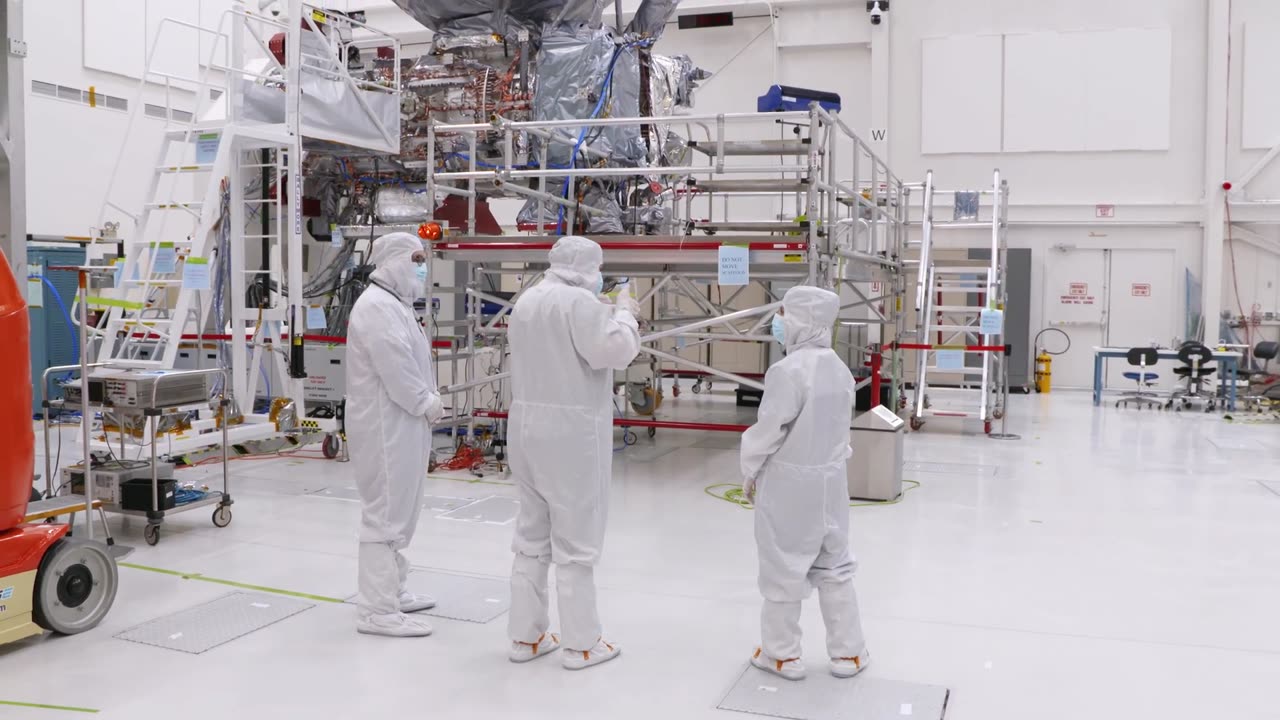Premium Only Content

Spacecraft Makers: Europa Clipper's Instrument Integration
#spacecraft #europaclippers #integration #spaceship #nasa #galaxies #spacerocket #rocket #aircraft #solarsystem #planets #wolfchamp
Spacecraft Makers: Europa Clipper's Instrument Integration
Hardware for NASA’s Europa Clipper spacecraft was developed at various institutions and facilities across the U.S. and Europe, including NASA's Jet Propulsion Laboratory. That work included the science instruments and other spacecraft components, such as the propulsion module, radio frequency module, solar arrays, electronics vault, and more.
During the assembly, test, and launch operations phase of the mission, engineers put together the spacecraft, test its various components, and prepare it for its launch and journey to Jupiter’s ice-encrusted moon Europa.
In this episode of the Spacecraft Makers video series, spacecraft assembly, test, and launch operations mechanical engineer Steve Barajas and science systems engineer Jenny Kampmeier provide a behind-the-scenes look at the nearly completed spacecraft in the High Bay 1 clean room at JPL.
The propulsion module for the spacecraft was built by the Johns Hopkins Applied Physics Laboratory (APL) in Laurel, Maryland, with help from NASA’s Goddard Space Flight Center in Greenbelt, Maryland, and JPL.
The science instruments were developed by APL, the School of Earth and Space Exploration at Arizona State University, Southwest Research Institute in San Antonio, JPL, UCLA, University of Michigan, University of Texas at Austin, and the Laboratory for Atmospheric and Space Physics at the University of Colorado Boulder.
Spacecraft Makers is a video series that takes audiences behind the scenes to learn more about how space missions, like Europa Clipper, come together. Europa Clipper will explore this icy moon of Jupiter to see if there are conditions suitable for life. The spacecraft needs to be hardy enough to survive a 1.6 billion-mile, six-year journey to Jupiter – and sophisticated enough to perform a detailed science investigation of Europa once it arrives at the Jupiter system in 2030.
Europa Clipper is expected to launch in October 2024 from Kennedy Space Center in Florida.
Spacecraft Makers: Europa Clipper's Instrument Integration
Hardware for NASA’s Europa Clipper spacecraft was developed at various institutions and facilities across the U.S. and Europe, including NASA's Jet Propulsion Laboratory. That work included the science instruments and other spacecraft components, such as the propulsion module, radio frequency module, solar arrays, electronics vault, and more.
During the assembly, test, and launch operations phase of the mission, engineers put together the spacecraft, test its various components, and prepare it for its launch and journey to Jupiter’s ice-encrusted moon Europa.
In this episode of the Spacecraft Makers video series, spacecraft assembly, test, and launch operations mechanical engineer Steve Barajas and science systems engineer Jenny Kampmeier provide a behind-the-scenes look at the nearly completed spacecraft in the High Bay 1 clean room at JPL.
The propulsion module for the spacecraft was built by the Johns Hopkins Applied Physics Laboratory (APL) in Laurel, Maryland, with help from NASA’s Goddard Space Flight Center in Greenbelt, Maryland, and JPL.
The science instruments were developed by APL, the School of Earth and Space Exploration at Arizona State University, Southwest Research Institute in San Antonio, JPL, UCLA, University of Michigan, University of Texas at Austin, and the Laboratory for Atmospheric and Space Physics at the University of Colorado Boulder.
Spacecraft Makers is a video series that takes audiences behind the scenes to learn more about how space missions, like Europa Clipper, come together. Europa Clipper will explore this icy moon of Jupiter to see if there are conditions suitable for life. The spacecraft needs to be hardy enough to survive a 1.6 billion-mile, six-year journey to Jupiter – and sophisticated enough to perform a detailed science investigation of Europa once it arrives at the Jupiter system in 2030.
Europa Clipper is expected to launch in October 2024 from Kennedy Space Center in Florida.
Spacecraft Makers: Europa Clipper's Instrument Integration
Hardware for NASA’s Europa Clipper spacecraft was developed at various institutions and facilities across the U.S. and Europe, including NASA's Jet Propulsion Laboratory. That work included the science instruments and other spacecraft components, such as the propulsion module, radio frequency module, solar arrays, electronics vault, and more.
During the assembly, test, and launch operations phase of the mission, engineers put together the spacecraft, test its various components, and prepare it for its launch and journey to Jupiter’s ice-encrusted moon Europa.
In this episode of the Spacecraft Makers video series, spacecraft assembly, test, and launch operations mechanical engineer Steve Barajas and science systems engineer Jenny Kampmeier provide a behind-the-scenes look at the nearly completed spacecraft in the High Bay 1 clean room at JPL.
The propulsion module for the spacecraft was built by the Johns Hopkins Applied Physics Laboratory (APL) in Laurel, Maryland, with help from NASA’s Goddard Space Flight Center in Greenbelt, Maryland, and JPL.
The science instruments were developed by APL, the School of Earth and Space Exploration at Arizona State University, Southwest Research Institute in San Antonio, JPL, UCLA, University of Michigan, University of Texas at Austin, and the Laboratory for Atmospheric and Space Physics at the University of Colorado Boulder.
Spacecraft Makers is a video series that takes audiences behind the scenes to learn more about how space missions, like Europa Clipper, come together. Europa Clipper will explore this icy moon of Jupiter to see if there are conditions suitable for life. The spacecraft needs to be hardy enough to survive a 1.6 billion-mile, six-year journey to Jupiter – and sophisticated enough to perform a detailed science investigation of Europa once it arrives at the Jupiter system in 2030.
Europa Clipper is expected to launch in October 2024 from Kennedy Space Center in Florida.
-
 LIVE
LIVE
BonginoReport
3 hours agoLibs Think Christmas is Gay & Racist (Ep. 195) - Nightly Scroll with Hayley 12/11/2025
8,837 watching -
 1:05:06
1:05:06
TheCrucible
2 hours agoThe Extravaganza! EP: 74 with Special Guest: Danny Polishchuk (12/11/25)
21K3 -
 LIVE
LIVE
Robert Gouveia
1 hour agoTyler Robinson Appears in Court! J6 Pipe Bomber Case Delayed!
1,418 watching -
 LIVE
LIVE
Red Pill News
3 hours agoFIRE CONGRESS - Dysfunction Is Destroying MAGA Agenda on Red Pill News Live
3,576 watching -
 LIVE
LIVE
Kim Iversen
1 hour agoTim Pool Tried To HUMILIATE Me. Now What? | Erika Kirk Conspiracies PROVEN and Debunked
1,935 watching -

Redacted News
2 hours ago"We must prepare for war with Russia!" NATO and Europe preparing for all out war | Redacted
100K28 -
 4:43
4:43
WallStreetBets
2 hours ago $1.12 earnedWallStreetBets is now on Rumble
6.29K9 -
 1:14:54
1:14:54
vivafrei
3 hours agoWhite Guilt, or White Supremacy? FBI Ping of Brian Cole Explained! Trans Madness & MORE!
116K31 -
 1:34:37
1:34:37
The Quartering
4 hours agoTyler Robinson Court Appearance, Gross Thinfluencers Destroying Women, AI Backlash & Deportations
130K37 -
 1:53:05
1:53:05
Darkhorse Podcast
5 hours agoScience: The Rebel Reboot | The 304th Evolutionary Lens with Bret Weinstein and Heather Heying
33.9K16